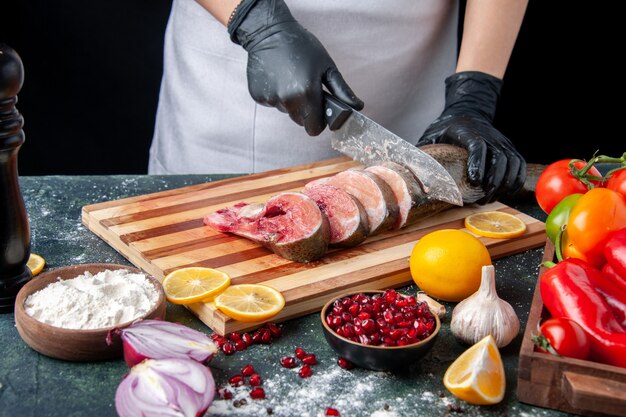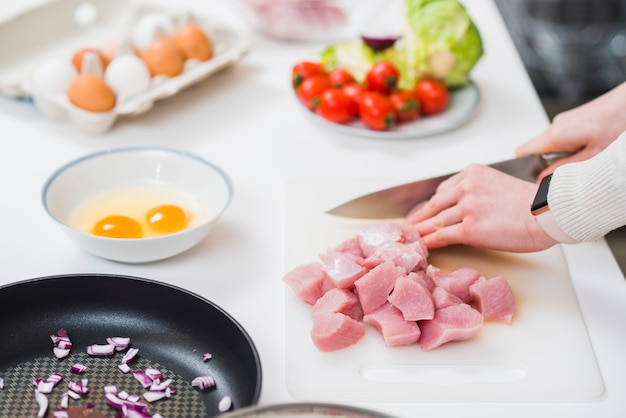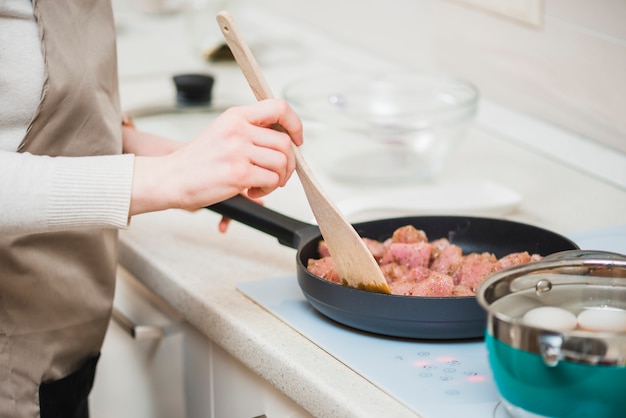Let's be honest, pork is a bit of a culinary chameleon. One minute it's the star of a crispy crackling roast, the next it's the hero of a melt-in-your-mouth pulled pork sandwich. But mastering the art of pork cooking, particularly getting the temperature just right, can feel like navigating a maze.
I've been there. I used to be the queen of overcooked pork, leaving it dry and tough as leather. Then I finally embraced the wisdom of the meat thermometer and discovered the joys of perfectly cooked pork. Now, I'm here to share everything I've learned, from the basics of pork safety to the nuances of different cuts and cooking methods. We'll unravel the mysteries of temperature, explore different techniques, and I'll even throw in a few of my personal tips and tricks along the way.
So, grab a comfy chair, pour yourself a cuppa, and let's dive into the world of pork perfection together.
(Part 1) The Basics of pork cooking temperatures

Pork Safety: The "No-Go" Zone
First things first, let's talk safety. Remember the days when pork was a bit of a food poisoning villain? Thankfully, those days are gone, thanks to proper handling and cooking methods. But, the key to keeping things safe is ensuring your pork reaches a specific temperature to zap any lurking bacteria.
The USDA (United States Department of Agriculture) recommends a minimum internal temperature of 145°F (63°C) for all pork cuts. That's the point where those pesky bacteria are toast, making your pork safe to eat.
Now, some chefs go a little higher, around 150°F (65°C), just to be extra cautious. I confess, I tend to lean towards that temperature too. It's all about personal preference, and ultimately, it's about ensuring a delicious and safe meal.
The Magic of Meat Thermometers
"But how do I know if my pork is cooked through?" you might be asking. That's where our hero comes in – the trusty meat thermometer. This little gadget is the unsung hero of the kitchen, particularly when it comes to pork.
You can find all sorts of thermometers, from simple analog models to fancy digital ones with all sorts of bells and whistles. I'm a fan of the classic analog thermometer; it's reliable, easy to use, and doesn't need batteries (always a bonus in my book!).
The technique is simple. Just insert the probe into the thickest part of the meat, ensuring it's not touching any bone. Let it sit for a few seconds, and voila! You have your reading.
Pork Cooking Methods: A Quick Overview
There are so many ways to cook pork, each with its own charm and benefits. Let's take a quick spin through the most popular methods:
Roasting: This is the classic way to cook large cuts like roasts or shoulders. It yields a juicy, tender result with a delightful crispy skin.
Grilling: Perfect for smaller cuts like chops or tenderloin, grilling gives that wonderful smoky flavor and char.
Pan-frying: A quick and easy option for chops or tenderloin, pan-frying delivers a crispy exterior and juicy interior.
Braising: This slow and gentle method is perfect for tenderizing tougher cuts like shoulder or belly. It creates a rich, flavorful stew.
slow cooking: This hands-off approach is ideal for tenderizing tough cuts and producing that melt-in-your-mouth texture.
(Part 2) The Perfect Pork Cooking Temperatures: A Detailed Guide

Now, let's dive into the heart of the matter – the precise temperatures for different cuts of pork.
1. pork loin: Lean and Tender
The pork loin is a lean and tender cut that's a favorite for grilling, pan-frying, or roasting. It's also a go-to for those delicious pork chops.
Internal Temperature: 145°F (63°C)
2. pork tenderloin: A Delicate Delight
Pork tenderloin is a small and delicate cut, known for its incredible tenderness and flavor. It's best cooked quickly over high heat, such as grilling or pan-frying.
Internal Temperature: 145°F (63°C)
3. Pork Chops: Versatility in a Cut
Pork chops are a versatile cut, easily adaptable to various cooking methods. Cook them over medium heat for even cooking and to prevent drying them out.
Internal Temperature: 145°F (63°C)
4. pork roast: A Hearty Meal
Pork roasts are the epitome of a hearty and flavorful meal. They're typically roasted in the oven until tender and juicy, a perfect choice for a family gathering.
Internal Temperature:
145°F (63°C) for a medium-rare roast
150°F (65°C) for a medium roast
160°F (71°C) for a well-done roast
5. pork shoulder: Slow and Tender
Pork shoulder is a tough but flavorful cut that benefits from slow and gentle cooking methods like braising or slow cooking. This allows the connective tissues to break down, resulting in incredibly tender meat.
Internal Temperature: 190°F (88°C)
6. pork belly: Crispy Crackling and Rich Flavor
Pork belly is the king of richness and flavor. It's perfect for roasting, braising, or slow cooking, delivering crispy crackling and melt-in-your-mouth meat.
Internal Temperature: 190°F (88°C)
7. pork ribs: A BBQ Classic
Pork ribs are a BBQ staple, typically cooked low and slow, often with a dry rub or sauce. This slow cooking method tenderizes the meat and creates that iconic, fall-off-the-bone texture.
Internal Temperature: 190°F (88°C)
(Part 3) Tips for cooking pork to perfection

1. Resting: A Crucial Step
After cooking your pork, let it rest for 10-15 minutes before carving. This allows the juices to redistribute throughout the meat, resulting in a more tender and juicy final product.
2. Don't Overcook: Avoid Dryness
Overcooked pork is a culinary tragedy! It can turn dry and tough. Keep a watchful eye on your pork, using a meat thermometer to ensure it's cooked to the right temperature.
3. Seasoning: The Flavor Boost
Seasoning your pork generously is essential. You can keep it simple with salt and pepper, or get creative with herbs, spices, and rubs.
4. Embrace the Fat: It's Flavorful
Pork can be a bit fatty, but that's what gives it its delightful flavor and juiciness. Don't be afraid to use the fat for cooking or basting. It adds a wonderful depth of flavor to the meat.
5. Try a Dry Brine: Enhance Juiciness
A dry brine is a simple technique that involves rubbing the pork with salt and sugar before cooking. It helps to draw out moisture and then reabsorb it, resulting in a juicier and more flavorful roast.
6. Use a Basting Brush: Keep it Moist
Basting your pork during cooking helps to keep it moist and flavorful. Use a basting brush to apply a marinade, sauce, or even melted butter.
7. Experiment: Discover New Flavors
The world of pork cooking is full of possibilities! Don't be afraid to experiment with different recipes and techniques. You might stumble upon your new favorite pork dish!
(Part 4) Understanding the Doneness of Pork
1. The "Pink" Factor: It's Normal
You might be surprised to see a hint of pink even when pork is cooked to the recommended temperature. This is perfectly normal and doesn't mean it's undercooked. It's simply a result of myoglobin, a protein found in muscle tissue.
2. The Texture Test: Firm and Springy
You can also tell if your pork is cooked through by its texture. Cooked pork should be firm and springy to the touch, not soft or mushy.
3. Visual Cues: Look for Clear Juices
While not as reliable as a meat thermometer, you can also use visual cues. Cooked pork will usually have a slightly darker color than raw pork, and the juices will run clear, not pink.
(Part 5) FAQs
1. Can I eat pork that's still slightly pink?
Yes, as long as it's cooked to the recommended internal temperature of 145°F (63°C), it's perfectly safe to eat pork that's still slightly pink. The pink color is just the myoglobin, a protein found in muscle tissue.
2. What's the best way to check the temperature of a pork roast?
The best way is to use a meat thermometer. Insert the probe into the thickest part of the roast, ensuring it's not touching any bone. Let it register for a few seconds, and then read the temperature.
3. Can I freeze pork?
Yes, you can freeze pork. Wrap it tightly in plastic wrap or aluminum foil to prevent freezer burn. Frozen pork can be stored in the freezer for up to 3-4 months.
4. What are the signs of spoiled pork?
Spoiled pork will have a sour or rancid smell, and the meat will be slimy or discolored. If you notice any of these signs, discard the pork immediately.
5. What's the best way to reheat cooked pork?
The best way to reheat cooked pork is in the oven or microwave. Make sure to heat it to an internal temperature of 165°F (74°C) to ensure it's thoroughly cooked.
(Part 6) Pork cooking mistakes to Avoid
1. Overcooking: A Dryness Disaster
Overcooking is one of the biggest pork-cooking sins. It can lead to dry, tough, and flavorless meat. Remember to cook pork to the right temperature and let it rest afterward to redistribute the juices.
2. Under-Seasoning: A Flavorless Tragedy
Pork can be a bit bland on its own, so don't skimp on seasoning! Generously use salt, pepper, herbs, and spices to bring out the flavor.
3. Ignoring the Fat: A Missed Opportunity
Pork's fat adds flavor and juiciness. Use it for cooking or basting to enhance the taste of your dish.
4. Ignoring Resting: A Juicy Mishap
Resting is a crucial step after cooking pork. It allows the juices to redistribute throughout the meat, resulting in a more tender and juicy final product.
5. Not Using a Meat Thermometer: A Guessing Game
The meat thermometer is your best friend when cooking pork. It's the only way to ensure your pork is cooked to the right temperature and avoid overcooking or undercooking.
(Part 7) My Personal Pork cooking tips
1. Embrace the Roast: A Simple Classic
I love roasting pork. It's a simple and delicious way to cook a large cut of meat. I typically season my roast with salt, pepper, garlic, and rosemary, and then roast it in the oven until it's tender and juicy.
2. Pan-fry with a Twist: Quick and Easy
For a quick and easy meal, I love pan-frying pork chops. I use a cast iron skillet for the best browning and sear. I add a bit of butter and herbs to the skillet, and then pan-fry the chops until they're golden brown and cooked through.
3. Braising for Tenderness: Slow and Flavorful
I'm a big fan of braising! It's a great way to tenderize tougher cuts of pork like shoulder or belly. I typically braise pork with onions, carrots, celery, and a splash of wine or beer.
(Part 8) Conclusion
So there you have it, my pork-loving friends! You're now armed with the knowledge you need to cook pork to perfection. Remember to cook pork to the right temperature, use a meat thermometer, and let it rest before carving. Experiment with different recipes and techniques, and enjoy the deliciousness of this versatile meat!
I hope this guide has been helpful and inspiring. Now, go forth and conquer the world of pork cooking!
Everyone is watching

Corn on the Cob: The Ultimate Guide to Perfectly Cooked Ears
Healthy MealsAh, corn on the cob. Just the name evokes images of sunny days, barbecues, and that sweet, juicy flavour that ...

Perfect Pork Roast Oven Cooking Time: A Guide to Delicious Results
Healthy MealsThere's something truly satisfying about a perfectly roasted pork. The aroma alone is enough to make your mout...

Ham Cooking Time: How Long to Bake, Smoke, or Boil a Delicious Ham
Healthy MealsAh, ham. It's a classic, isn't it? A real crowd-pleaser, especially around holidays. And when done right, it'...

Scallops: The Ultimate Guide to Perfect Cooking
Healthy MealsAh, scallops. Those delicate, sweet, and utterly delicious morsels of the sea. They hold a special place in my...

Spaghetti Squash: The Ultimate Guide to Cooking and Serving
Healthy MealsRemember that time you saw spaghetti squash at the supermarket, looking all bumpy and strange, and thought, "W...
